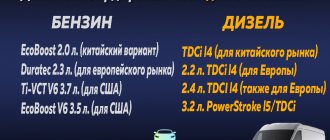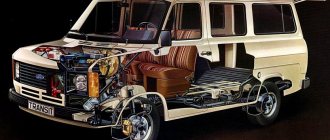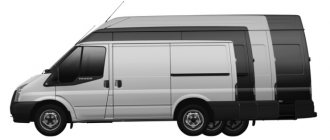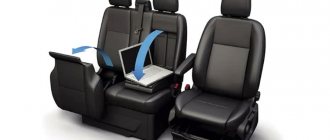Engines of the Puma family, also known as Duratorq, appeared on Ford cars in 2000. We have already talked about these engines for the 3rd generation Ford Mondeo and for the Ford Transit. These are purely German turbodiesels that have nothing to do with engines from the PSA concern.
Since 2006, German diesel engines of the Puma family have left Ford passenger cars, but they are still used in commercial Fords. Also, since 2006, these engines have been installed on commercial clone cars of Peugeot Boxer, Citroën Jumper, Fiat Ducato under the catalog designation 4H or P22DTE (thus, these cars were equipped with completely different 2.2-liter engines from Ford and PSA (DW12)), as well as Italian Iveco/Sofim engines of 2.3, 2.8 and 3.0 liters).
German Puma turbodiesels for commercial vehicles have been constantly evolving. Since April 2006, they have completely switched to a Common Rail fuel system supplied by Denso. Also, since 2006, the cylinder head has been seriously changed, in particular the design of the valve drive. Even later, at the turn of 2012, these Euro-5 engines received a vane-type oil pump.
With each such innovation, Puma engines developed weak points that became the causes of serious breakdowns.
On our YouTube channel you can watch a disassembly of the 2.2 TDCi engine from a 2006 Ford Transit (P8FA, 85 hp).
You can select and buy an engine for Ford Transit in our catalog of contract engines.
Turbocharger
Since 2006, Ford Puma (Duratorq) engines have mainly used variable geometry turbines, also with an electronic servo drive. This is the Garrett GTA1749VK turbine, which Duratorq diesels previously received for the Ford Mondeo. Sometimes on early copies produced before the end of 2007, there are turbines with a wastegate - this is the Mitsubishi TD03 turbine. Such turbines received engines without a particulate filter. The Garrett turbine has a problem servo. When the geometry blades jam, the gears in it wear out or burst. The electric motor may also fail, and the contacts on the board connecting it to the connector may crack.
You can select and buy a turbine for a Ford Transit engine in our catalog of contract engines.
Engine life Ford Transit 2.0, 2.2, 2.4, 2.5
In the middle of the last century, Ford Motor Company engineers were tasked with creating a comfortable van for the European market. The first car to wear the “Transit” emblem was the Ford Taunus, produced in 1953 by the Cologne car plant. However, the truly first Transit was the second generation car. Its production started in 1965 and continued until 1978. At that time, the Ford Transit was truly a unique vehicle, capable of transporting almost any large cargo.
Today, the term “Transit” among car enthusiasts is considered to be any car in the commercial segment with performance characteristics similar to Ford. For 40 years, the model remained the best-selling in its class on the European market. The first five generations are reliable and practical machines for business and general use. Modern models of the 5th-8th generation, in addition to versatility, are also endowed with a unique appearance. Production of the latest generation began in 2013 and is still ongoing. Before buying a van, it is advisable to familiarize yourself with the service life of the Ford Transit engine.
EGR valve
The EGR valve on all updated Puma engines (since April 2006) participated in the recall campaign. As it was used during the warranty period, this valve began to work incorrectly due to the failure of the potentiometer of its position sensor. At the same time, the engine lost a lot of traction, smoked black smoke and just barely moved. At the same time, errors were recorded indicating malfunctions in the exhaust gas recirculation circuit.
The valve was replaced with an improved one. But in practice, problems with the potentiometer may also arise in it: its service life is estimated at 200,000 km. Today, there are enough offers for this valve, including Chinese substitutes starting at $100. But the most affordable prices are for a used EGR valve.
You can select and buy an EGR valve for a Ford Transit engine in our catalog of contract engines.
injection pump
Puma engines with a Common Rail fuel system are equipped with a Denso HP3 fuel injection pump. This pump creates fuel pressure up to 1800 bar. This is a good and durable pump, but it does not like contaminants in the fuel and hard fuels. To extend the life of it and the injectors, you need to install an original filter that filters out all impurities larger than 5 microns. If you have doubts about the quality of diesel fuel, you should add 2-stroke oil to it. Very radical methods of prevention are refueling with settled fuel and installing an additional fine filter. In addition, you need to properly fill the filter with fuel. The procedure is described in the instructions: you need to fill the filter with fuel using a hand pump (“bulb”) through the inlet fitting on the filter bracket. Usually this is neglected and fuel is poured into the filter before installing it on its bracket. In this case, the filled fuel enters the injection pump without filtration.
The weak point in the Denso HP3 injection pump is the pumping section, which is a rotary trochoid pump (“star within a star”). Due to problems with fuel quality, he is slowly chipping away. Very little of this chips is formed. First of all, it gets into the flow control valve (SCV valve) and slowly wears out its spool and body. If on a Denso HP3 pump, with regular replacement of high-quality filters, the flow valve does not last more than 100,000 - 150,000 km, then the injection pump must be sent for repair. Most likely, the elements of the booster pump will need to be replaced.
The Denso HP3 fuel injection pump (DCRP300400) on Puma engines is the same for versions with power from 85 to 140 hp.
You can select and buy a fuel injection pump for a Ford Transit engine in our catalog of contract engines.
Duratorq engine life
Duratorq engines include 16-valve TDCi units with an advanced Common Rail fuel supply system and a common fuel rail. These power plants provide decent torque throughout almost the entire operating range, which contributes to the Ford Transit's excellent payload capacity, equal to a maximum value of 1.4 tons. The motors of the family are characterized by quiet, smooth operation with minimized noise and vibration levels. Diesel engines were made according to the classical design: a cast-iron cylinder block and an aluminum head. There are four valves for each cylinder. Also, Ford engineers subsequently improved the ventilation system, eliminating possible engine overheating.
Technical characteristics of Duratorq family units:
The Duratorq series motors are designed with advanced technology and a high pressure manifold mounted on the intake. Power units meet all environmental requirements. In 2008, to comply with Duratorq diesel engines above Euro 4 standards, a special particulate filter was installed. An innovative approach to the design of power units allowed Ford to bring its developments to near perfection. Duratorq motors are not only economical, flexible and smooth in operation, but also resource-intensive.
According to unofficial data, the service life of diesel engines is 300 thousand kilometers. The manufacturer itself does not comment on this matter. The practice of operating a Ford Transit shows that the figure of 300 thousand kilometers achieved by a van is a kind of minimum. The version of the car with a petrol 2.0L EcoBoost engine is capable of traveling 350 thousand kilometers before the first major repair.
Flow Control Valve (Reducing Valve)
A pressure reducing valve (Denso DCRS30-0260) located on the injection pump continuously controls the fuel supply to the plungers. Those. it controls the flow of fuel and thus it is it that maintains the fuel pressure in the rail that corresponds to the load on the engine.
The valve is a linear solenoid that moves a needle valve. It happens that surface scratches appear on the spool, due to which the needle gets wedged in the body. For this reason, the idle speed “floats” first and the engine periodically stalls, because the valve cannot accurately “hit” the required fuel pressure in the rail. In this case, the valve needs to be replaced, since today it costs less than $100. There are also plenty of non-original valves on sale, but they are characterized by a low service life and poor manufacturing quality of the chip in which contact is lost. There is also a popular method for reviving a stuck valve: disassembling the valve, polishing scratches on the needle and in the body.
When installing the SCV valve, you must be careful not to damage the valve O-ring, because then a fuel leak will appear. After installation, the valve must be adapted. On Ford vehicles this is done using a Chinese OBD scanner and an unofficial diagnostic application (ForScan).
Heat exchanger thermostat
Like passenger diesel engines for the Ford Mondeo, engines for the Transit have a second thermostat to regulate the temperature in the heat exchanger. This thermostat comes with a plastic housing and an O-ring on it. It is often necessary to change this thermostat due to antifreeze leaking through its body.
Also, the heat exchanger and oil filter housing often leak oil. To eliminate the leak, you need to change the gasket between the heat exchanger and the housing, as well as the plastic oil filter cover. It is not eternal and does not hold a “twist” over time. The sealing ring of the cover comes complete with a filter insert and is replaced with every oil change.
Denso injectors
The fuel system of the 2006 Puma (Duratorq) engines uses Denso G2 type electromagnetic (solenoid) injectors (DCRI105800). All that can happen to these injectors is excessive fuel drainage into the return line. If the drainage is too intense, the engine does not start well and stalls under load, because... The injection pump cannot maintain fuel pressure in the rail.
Excessive fuel drainage occurs due to wear of the passage valve (aka membrane): tiny grooves form on its steel surface, which are scratched by too sulfurous or dirty fuel. After this, the valve does not hold fuel pressure.
Such an injector can be restored by replacing the valve, but it is also necessary to inspect the injector rod for wear. Inspection can be carried out using a microscope - wear is hardly noticeable to the naked eye. The cost of such injectors today is low - about $180, but used ones are even cheaper. The injectors should be installed on new copper washers, and the injectors should be secured with new bolts. After installation, the injectors should be registered to reset the adaptations of old worn out injectors.
You can select and buy injectors for the Ford Transit engine in our catalog of contract engines.
Injectors
Distribution injection pump injectors are simple and reliable. They run for a long time, and if there is a malfunction, they start knocking while the engine is running. You can detect a knocking injector with the engine running by loosening the injector fittings one by one. The knocking injector will “go silent” when diesel fuel begins to seep through the fuel line nut.
By the way, these injectors perform double fuel injection. For this purpose, their design provides two springs. One allows the spray needle to open at a pressure of 225 bar, and the second at 420 bar. This is done to prevent dangerous pressure surges in the cylinders.
Valve train chain
Since 2006, commercial Ford Duratorq (Puma) engines have switched to a single-row timing chain. On a Ford Transit engine with a transverse arrangement, the timing chain has 122 links, and the fuel injection pump is driven directly from the camshaft.
A single-row timing chain lasts about 200,000 km. Its jump occurs in the most advanced cases, since on a 2.2-liter transverse engine the chain coil wraps well around the intake camshaft. Those. Jumps are more common on a 2.4-liter engine, where the chain branch is diverted to the side towards the injection pump drive gear.
Problems and reliability of the Ford 2.4 Duratorq (Puma) turbodiesel for Transit
The Duratorq engine line appeared in 2000. In our countries, the most common Puma engines are 2.0, 2.2 and 2.4 liter power units. These engines, designed for Ford Transit, debuted with direct injection based on Bosch VP30 and VP44 distribution fuel injection pumps, and closer to 2006 they completely switched to Common Rail injection from Delphi. These power units are still produced today. All versions of the Puma inline fours are very similar in cylinder head and cylinder block, although in 2006 and later there were some changes in their design.
cylinder head
What's new in the cylinder head of the 2006 Ford Puma engines? The rocker arms have been changed here. If previously all the rocker arms were “strung” on two axles, now all the rocker arms are suspended from a common frame. The rocker arms themselves have become much lighter and thinner. But that's not the problem.
The problem is hydraulic compensators, which last about 200,000 km. Usually only one hydraulic compensator is rented. At the same time, a frequent muffled knock appears: this is the rocker hitting the weakened hydraulic compensator. In this case, a pulsation is observed in the intake manifold - it can be felt by touching the intake pipe.
This engine cannot be operated with a weakened hydraulic compensator. Because very quickly the “jumping” rocker will lie on its side and fall off. In the worst case, it can get under the camshaft cam. At the very least there will be a scratch on the cam. There are also times when the rocker breaks in half or becomes warped, causing a groove to form in the cam.
If the Puma engine rattles, you need to immediately go for a replacement - replacing the entire rocker frame, because hydraulic compensators come complete with it (and with rockers). The frame costs about $300.
It is also worth, if possible, lifting the valve cover and manually testing the hydraulic compensators. If sagging parts are found, the frame should be replaced before the motor begins to rattle. The same check should be carried out 200,000 km after replacing the frame and hydraulic compensators.
You can select and buy a cylinder head (cylinder head) for a Ford Transit engine in our catalog of contract engines.
Oil pump
Until 2011, Puma engines used a normal gear-type oil pump (its catalog number is Ford 1456884 or Pierburg 729621050). It does not cause any complaints, and cases of wear and tear are extremely rare.
Since 2011, with the transition of these engines to Euro-5, a vane-type pump has appeared in the oil system. From the outside it looks almost identical to the old one and is completely interchangeable with it.
The vane pump caused a nightmare for owners of cars with a Puma (Duratorq) engine.
The vane blades, made of some synthetic material (plastic or fluoroplastic), simply broke off. As a result, the lubricant pressure dropped to zero, and the engine experienced oil starvation. At the same time, a red oil can lit up on the instrument panel; in fact, it already reported the appearance of serious engine damage. First of all, the cylinder head and turbine suffered due to lack of lubrication, and if the driver allowed himself to continue driving at a low pressure level, the liners were welded to the crankshaft journals, the engine began to knock and quickly jammed.
The oil pump blades broke off after a mileage of 40,000 - 60,000 km. Warranty engines were replaced at dealers, and oil pumps were also replaced with improved ones during the recall campaign.
But still, these vane oil pumps are not particularly trustworthy. Those. The actual oil pressure should be measured - it may be reduced if the valves are worn out or several of them are broken.
It is most reliable to install an old gear pump with its oil intake instead of a vane pump. It fits Duratorq motors manufactured since 2011 without any problems.
You can select and buy an oil pump for a Ford Transit engine in our catalog of contract engines.









